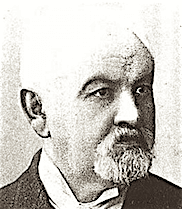
James Brooks was born in Hatford, Berkshire, England on 30 March 1825 and was articled to Lewis Stride (1823-1879) from 1847. He also studied at University College, London and at the Royal Academy Schools in London.
He commenced practice in London in 1851 and was known primarily as a a church architect. From 1888 he was Architect to the Diocese of Canterbury and was consulting architect to the Incorporated Society for Building Churches.
Brooks practised alone until 1894 when he formed a partnership with his son, James Martin Brooks (1852?-1903) as James Brooks & Son. They were joined by George Herbert Godsell of Herbert in c.1900 and the practice was renamed James Brooks Son & Godsell.
In 1866 he was elected a Fellow of the Royal Institute of British Architects (FRIBA) and from 1892 to 1896 was its Vice-President. In 1895 he was awarded the Royal Gold Medal. He exhibited at the Royal Academy in London from 1853 to 1899.
Brooks's business address was given as 11, Serk Street, Lincoln's Inn, London (1871, 1875); 35 Wellington Street, London (1876, 1891); and 6 Bloomsbury Street, London (1884, 1895). From 1862 he lived at The Grange, Stoke Newington, Middlesex [now London], where he died on 7 October 1901.
Works by Brooks and his practise included Parish School, Henley-on-Thames, Oxfordshire (1856); Baptist Chapel, Wantage, Berkshire (1860); The Grange, 42 Clissold Crescent, London (1861-62); Framland, Challow Road, Wantage, Berkshire for J. Mackonockie (1862); The Grange, Stoke Newington, Middlesex [now London], built for himself (1862); St. Michael's Church, Mark Street, London (1863-65); Parish School, Headington Quarry, Oxford (1864); St. Saviour's Church, Hoxton, London (1865-66); St. Andrew's Church, Plaistow, London (1867-70); St. Columba's Church, Kingsland Road, London (1868-69); St. Chad's Church, Dunloe Street, London (1868-69); Church of the Annunciation, Chislehurst, Kent (1868-70); National Schools, Wolstanton, Staffordshire (1871-72); Rectory, Maiseyhampton, Gloucestershire (c.1872); St. Saviour's Church, Mortomley, Yorkshire (1872); St. John the Baptist's Church, Holland Road, London (1872); W. W. F. Hume Dick Mausoleum, Kil;tegen, Co. Wicklow, Ireland (1875); St. James' Church. Marston Meysey, Wiltshire (1875-76); Church of the Ascension, Lavender Hill London (1876-83); St. Madoc's Church, Doune, Perth (1877-78); Church of the Transfiguration, Algernon Road, London (1880-86); St. Peter's Church, St. Leonard's-on-Sea, Sussex (1883-85); Church of the Holy Innocents. Paddenswick Road, London (1889-91); Saints Peter and Paul church,. Dover, Kent (1891-93); and All Hallows church, Savernake Road London (1892-1901), chancel completed by Giles Gilbert Scott in 1913-15.
_____
See also:
Historic England [link below]
British Listed Buildings [link below]
Wikimedia Commons [link below]
Adkins, J. Standen. ‘James Brooks: a memoir’. Journal of the Royal Institute of British Architects vol. 17, 1909-10 pp. 593-516
Avery, Derek. Victorian and Edwardian Architecture. London: Chaucer Press, 2003
Baggallay, Frank T. ‘The Late James Brooks’. Architectural Review vol. 10, 1901 pp. 218-224
Directory of British Architects 1834-1914. Compiled by Antonia Brodie, et al. Volume 1: A-K. London; New York: British Architectural Library, Royal Institute of British Architects/Continuum, 2001
Dixon, Roger Edmund. Life and Work of James Brooks. Ph.D. thesis, Courtauld Institute of Art, 1976
Hyland, Anthony. ‘James Brooks, architect (1825-1901)’. American Architect & Building News vol. 74, 1901 pp. 33-34
‘Mr Brooks's Churches’. Architecture vol. 4. 20 August 1870 p. 108
‘Obituary’. American Architect & Building News vol. 74, 1901 pp. 33-34
‘Obituary’. The Builder vol. 81, 1901 p. 321
‘Obituary’. Journal of the Royal Institute of British Architects vol. 8, 1900-01 p. 504